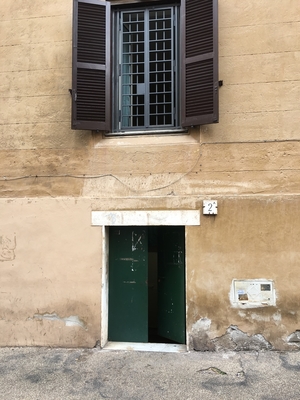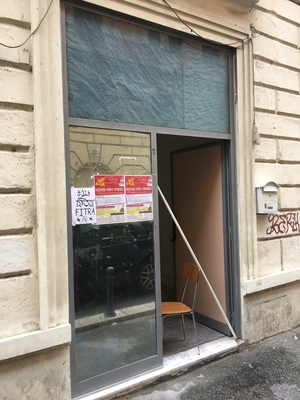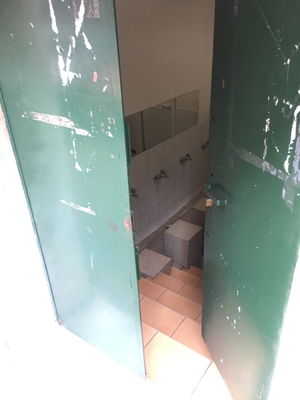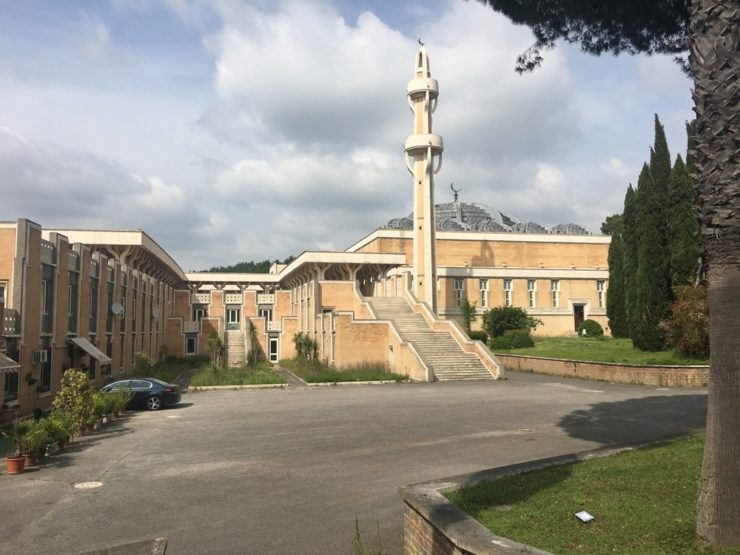
The following essay was written by Saskia Huijgen in the context of the KNIR masterclass on religions and the image question in Rome, May 2019.
Beholding a very large religious building always has a deep impact on me. It makes me want to pause for a while to take the time to just look and feel a sense of amazement. This feeling might come close to what Meyer (2015, 8) describes as the ‘wow’ effect: “of which the body is a potential harbinger, prone to experience spectacular “wow” effects and a sense of wonder and amazement.” I specifically remember this happening to me when I saw the Duomo di Firenze for the first time. Maybe I have romanticized it in my head now, but I feel my jaw literally dropped when gazing at this enormous basilica for the first time.[1] The same happens when I see very big mosques, which I for example experienced with the Blue Mosque in Istanbul, the al-Aqsa in Jerusalem and most recently the Mohammad Al-Amin mosque in Beirut. It should not be too much of a surprise since these buildings are, after all, very eye-catching. While I might be more programmed towards this feeling because of my interest in religion, I recognize this feeling also in people who are not involved in religious studies or do not have any particular interest in religion. Mattijs van de Port (2013) even describes how his nipples were hardening when entering the Igreja de São Francisco in Salvador which brings him to the conclusion that “the body is as much a medium as the church. Both are sensation-producing instruments” (van de Port 2013, 63).
Thus, when I learned there was an enormous mosque – by many labelled as the biggest mosque in Europe[2] – present in the Catholic center of the world, Rome, I started wondering in what way this mosque was a “sensation-producing instrument”. Being a very big mosque in such a specifically Catholic environment has to, in a way, influence the experience of the presence of Islam in Italy, I thought. In this paper, I will take the Moschea di Roma (the mosque of Rome) as an entry point for questions about the position of Islam in Italy and more specifically in Rome. David Morgan’s (2017) material analysis inspired me to take an object as a starting point for asking questions. According to him, “material culture is more than an object. It is the way in which an object participates in making and sustaining a life-world” (Morgan 2017, 15). Taking the mosque as an entry point of research, allows me to explore the “visual regime” in Rome. “Visual regimes govern practices of display, revelation and concealment”, and researching the context of a visual regime reveals the organization of “how and what people see and sense and what value they attribute to it” (Meyer 2015, 338 / 356). On the one hand, this paper tries to find out what the presence of this mosque indicates for the visibility of Islam in Rome as a city that is subject to a particular visual regime. What is the socio-political position of a religious minority such as Muslims in catholic Italy? What does the presence of this enormous mosque tell us about it? On the other hand, this paper will analyze the mosque as a sensation producing instrument – though it might only be in people’s imagination. As van de Port says, the body is as much a mediating system as the building. How does the (very visible) presence of the mosque affect emotions towards the (rather unseen) Islamic identity? And how do Muslims feel strengthened in their identity because of this mosque? Theories on the visual regime (Meyer 2015; 2019), imagination in the mega-mosque genre (Tamimi Arab 2013) and the material analysis of buildings (Verkaaik 2013) will be reviewed and prove helpful in finding answers to the beforementioned questions.
Verkaaik (2013) argues in the book Religious Architecture how religious architecture does not merely express identity but also performs religious identity. The religious building “as representing not just identities to the outside world but ways to broaden and internalize one’s knowledge of religious doctrine or deepen one’s faith” (Verkaaik 2013, 9-10). In this paper it will be seen whether the Moschea di Roma deepens Muslim’s faith in the way Verkaaik describes here. The religious building as part of a visual regime is an insightful lens to look through when trying to understand political-aesthetic practices which constitute Muslim identity in, for example, the European, and in this case the Italian, context.
Before analyzing the implications of the presence of this big mosque, I will address the history of the run up to the construction of the Moschea di Roma. In 1974, the Rome City Council decided to donate a plot of land in the Mount Antenne / Parioli area (in the north of Rome) to the Islamic Cultural Center in Rome. This was during a time of intensified relations between Italy and the Arab world, in a political context of the oil crisis, which meant any possibility to secure oil supply was desired. The Italian prime minister Andreotti framed the increased diplomatic visits as an attempt “to build up a set of common interests between ‘Christian Europe’ and Islam, in search of the cohabitation, forced if necessary, between a plethora of states and political proposals” (Laurence 2012, 69). Also, Muslim immigration to Italy started from the 1970s onwards, which increased the need for an actual place of worship for Muslims (Allievi 2003, 145). During a visit in 1972, Saudi king Faysal bin Abdul Aziz formally requested the Italian government to construct a mosque. Though it is debatable whether this was really for the recently immigrated Muslims, Andreotti had said in an interview that the immigration provided “political, strategic and symbolic” motivations for the building of a mosque (Laurence 2012, 70). In any way, the request was authorized and accepted at the time by prime minister Andreotti and even Pope Paul VI gave his blessing, saying it “would enrich Rome’s civilization” (Laurence 2012, 69). A group of ambassadors from Islamic country subsequently assisted in the funding. An international competition followed for architects that could send in their designs for the mosque. The competition was won by Italian star architect Paolo Portoghesi[3] who worked together with engineer Vittorio Gigliotti and Iraqi architect Sami Mousawi in realizing the design and the building of the mosque. This collaboration resulted in a combination of Italian and Iraqi influences on the design, which explains why the mosque does not have a typical Arabic outlook, but is really a mixture of both. According to Troelenberg and van Loan (2019), this points to a “concept of diaspora, which ‘undermines the supposedly fixed and natural relationship between identity and place’”. According to them, the tiles of the moschea are created in a traditional technique and at the same time it is merged with features of Roman classicism and thus consolidates the presence of an Islamic community in Europe (Troelenberg and van Loan 2019, 428). It took quite a few years to build the enormous Islamic house of worship and cultural center and in 1995 it was officially finished and opened. As said before, the mosque is coined as “the biggest mosque of Europe”, which is not a strange label for a mosque that has a huge plot of land, its Wikipedia page claiming it can house 12,000 people at the same time. The picture below can give you an idea of how big the mosque is and in what kind of area it is located.
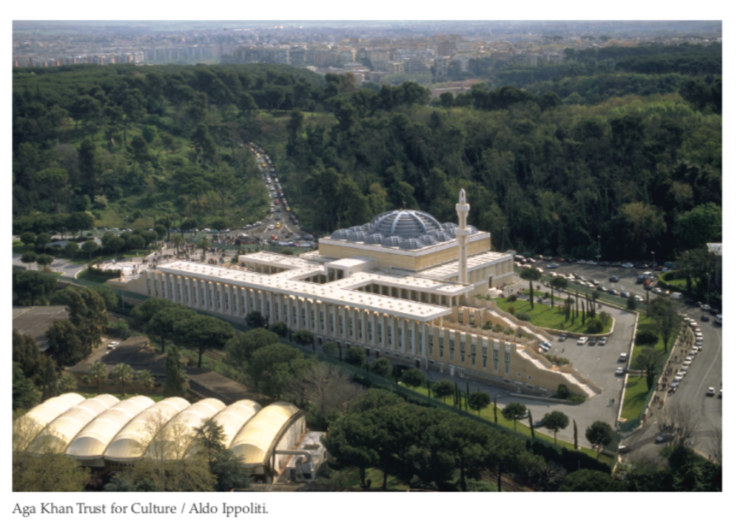
During the time of construction, the expectations of the mosque seemed to be quite high. The mayor of Rome at the time, Giulio Carlo Argan, said about the mosque that it is “a building through which Rome will learn about Islam, thus opening a new perspective on a world that we know only in an approximate manner. This means considering architecture as a doorway to knowledge” (Demetra Spigolature, 1994). In an article in the New York Times, the construction of the mosque was remarked as “the first mosque in the city of St. Peter… The only one located in the heart of Christianity, in the Mecca of Catholicism, you might say” (Haberman 1989).
It was clearly emphasized that the arrival of the mosque indicates an opening of a dialogue among the different religions of Rome and in a way, acceptance of the presence of Islam in Rome and Italy in general. This all sounds quite promising, at least that is what one might think when reading into the history of this mosque. I decided to take a small fieldtrip to the mosque after reading all these promising words. It was insightful to see the mosque not only from pictures and to see how it is experienced by worshippers. To be honest, the mosque was quite a deception. It is indeed, very, very big and it is impressive to see how Italian and Arab architecture styles are mixed into one building. However, the place was rather deserted when I arrived there, and notably, it was during the time of Ramadan, a time in which normally there is much activity in a mosque. Tamimi Arab (2013) also described a similar experience of his visit to the mosque: “Expecting “the biggest mosque of Europe”, visitors often encounter only a handful of people. Only on Fridays do believers show up in some numbers” (Tamimi Arab 2013, 50). It turns out that this mosque is everything but the center of Islam in Rome. This has much to do with the location. The mosque is located in the Parioli district, about 9 kilometers from the city center of Rome, and it is not in a neighborhood where many Muslims live. This neighborhood is characterized by upper middle-class residential apartment buildings and the Villa Ada Park, which used to be a residence of the Italian royal family (Salam 2001, 1). Thus, it turns out that the moschea does not seem to make Islam “visible” in Rome, as the mosque is very invisible for the average Roman citizen, Muslim or non-Muslim. The Roman Muslim community instead prays at mosques in the city center which look more like the opposite of the Moschea di Roma. Usually it is not visible from the exterior that they are mosques at all, just usual buildings whose basements are used for worship, similar to the phenomenon of clandestine Catholic churches[4] in the Netherlands during the 17th century. What does the existence of the Moschea di Roma together with the hidden mosques say about the visual regime in Rome and its stance towards Islam?
Main stream Roman mosques or prayer basements in the city center of Rome (pictures by author)
Saint-Blancat and Schmidt di Friedberg (2005) wrote an article on “why mosques are a problem in Northern Italy” in which they say that the main problem for mosque construction lies in the visibility in the public space, “something that Muslims are fully aware of, and which also affects a non-Muslim audience” (Saint-Blancat & Schmidt di Friedberg 2005, 1101). This makes clear that the actual presence of a mosque does something with those that receive the presence, who gaze at it or experience it in daily life. Meyer (2019) also pointed out that visual regimes inform attitudes toward art and visual culture on the part of religious practitioners as well as non-religious persons (Meyer 2019, 352). This means that the visual regime and the acceptance of a mosque to be present influence those who see the mosque. The presence of a mosque has agency in a way that makes people realize that (Muslim) immigrants are here for the longer run and this is actually a sensitive topic within Italian politics. This might be the reason that an actual Islamic building is located in such a far place outside of the sight of many.
Parties such as Lega Nord and MoVimento 5 Stelle, have been actively pursuing an anti-migrant / Islam policy and are gaining in popularity[5] in the Italian political system. These political parties definitely do not want Muslims to stay for the longer run and they are actively working against Islamic permanent presence, which the building of mosques would signify (Gostoli / Al Jazeera 2018). It consequently comes down to the question whether Muslims are seen as a legitimate member of Italy’s public space. This is also related to the complex relationship between local and national politics and the Catholic Church’s monopoly on cultural values, which includes the visual regime, versus the premises of a secular society. In Italy, and thus in Rome, the Catholic church clearly is present everywhere, in the buildings and other parts of the visual sphere and there is not much room for deviation. This particular visual regime and anti-immigrant politics is possible because of the Italian context in which the religion of Islam is actually not recognized as an official religion (World Atlas 2017). There is freedom of religion in the Italian constitution, but Islam is not one of the acknowledged religions, which has consequences for some legal tax issues. Since 1984, there is no official state religion in Italy anymore, but acknowledging a religion has legal and financial consequences. Very peculiar for the Italian context is that every Italian citizen has to spend 0,8% (otto per mille) of their annual income to an organized religion, or social assistance system of the government. In this specific context, it is quite problematic that Islam is not officially recognized, because it means that Islamic institutions do not receive funds like churches do and Italian Muslims are obliged to spend their taxes on a religion that they do not follow. This contextualizes the Italian Roman Catholic visual regime, which finds its foundations also in legal and state matters, thereby creating the conditions of Islam’s exclusion from Italian public space. Another sign of this was the protest of hundreds of Muslims in 2016, next to the Colosseum in Rome, problematizing the shortage and closing down of mosques in Italy. The large group of Muslims staged a mass prayer outside to ask attention for not having enough official mosques (Agerholm 2016). Apparently, the enormous Moschea is not regarded accessible, close or even visible enough.
Even though Islam is clearly still not that visible, despite the existence of the Moschea, there is still this discourse of Rome having the “biggest mosque of Europe” and a religious building such as this one can still be a “sensation producing instrument”. Meyer’s concept of “aesthetic formation” is applicable here, which “captures very well the formative impact of a shared aesthetics through which subjects are shaped by tuning their senses, inducing experiences, modeling their bodies and making sense, and which materializes in things” (Meyer 2009, 7). This concept tries to tie the religion-media-community nexus together and it explains how the presence of material, such as the Moschea, can produce an imagined community (à la Benedict Anderson), such as the Islamic community in Rome, experienced as tangible and real. Seeing the Moschea as the biggest mosque in Europe might influence the way the imagined community of Muslims in Italy is experienced. The discourse revolving around the Moschea, according to Tamimi Arab (2013), fits the mega-mosque genre very well. This is not only because it is branded as the biggest mosque in Europe, which actually many mosques all over Europe claim to be[6], but also because this image is created of the mosque being right at the center of Christian-European heritage, as a sort of provocation or extreme openness to different religions. In this way, the presence of the mega mosque affects the Islamic community in Rome experienced as real, imagined tangible outside the realm of the mind and it is materialized through architecture. This strong image of an enormous mosque in the center of Roman Catholicism reaches out to Muslims all over the world and is thus envisioned in many Muslim’s minds. Throughout the internet, the Moschea di Roma is described in many travel blogs of Muslims from all over the world who were very impressed when visiting this mosque.[7] However in reality, as pointed out before, the Moschea is not located in a prominent place in Rome, not very visible and as it is not visited often by the regular Roman Muslim, it might not have the envisioned production of sensation, or be as aesthetically forming. At the same time, next to the mosque is the Islamic Cultural Center, where Muslims do celebrate important Islamic rites such as weddings, acceptance of conversions or funerals, including assistance to relatives of Muslims who died. In this way, the building does play an important role in creating better conditions for Muslim social practices and education and thus the ability to materialize the Islamic community, outside Muslim’s imagination or private houses. It is unfortunate that I was not able to ask Roman Muslims themselves how they experience this particular mosque and whether they see it as an important center of their experienced faith in Rome or whether it functions as a source of pride. This might be interesting for further research on the Moschea and the aesthetically forming role it can play in the Roman Muslim community.
Overall, it is very fruitful to have a religious building such as the Moschea as an entry point for research, when trying to better understand the context of Islam in Italy. While initially perceiving the presence of this mega mosque as a positive sign for the position of Islam, a closer look at the context and history of this mosque reveals the paradoxicality of the building. It is an enormous, and thus visible, Islamic building in Rome, the center of Roman Catholicism, but at the same time it is – due to its location – still very invisible for the general Roman people. Doing more research on this mosque, also reveals mixed effects that this building can have on the Muslim community in Rome. It reveals the very strict visual regime of Rome, which is still very much focused on Catholicism and it, to some extent, resonates with Italy’s political and legal context on the position of Islam in Italian society and the place that it can have in Italy’s public space. On the other hand, the Moschea does provide Muslims a place to practice important Islamic rites and the strong image of the mosque in a Catholic center does live on in the minds of many Muslims all over the world. In this way, the discourse around the mega-mosque, “the biggest mosque of Europe” (and that in a Catholic country) is still aesthetically forming and thus is in its own way a “sensation producing instrument”, may it be only in the minds of some Muslims.
References
Agerholm, Harriet. “Muslims stage mass prayer protest over closure mosques in Italy, The Independent, via this link.
Allievi, Stefano. “Sociology of a Newcomer: Muslim Migration to Italy – Religious Visibility, Cultural and Political Reactions.” Immigrants & Minorities 22, no. 2-3 (2003): 141-54.
Allievi, Stefano. “Immigration, religious diversity and recognition of differences: the Italian way to multiculturalism.” Identities 21, no. 6 (2014): 724-737.
Gostoli, Ylenia, “Italy’s Muslims uneasy after election of far-right government”, Al Jazeera 26th September 2018, Link. Accessed 1st of June 2019.
Haberman, Clyde. “Rome Journal; A Mosque Is Built, Finally, In the City of St. Peter.” New York Times. 1989. Link. Accessed 24th of May 2019.
Laurence, Jonathan. The Emancipation of Europe’s Muslims: The State’s Role in Minority Integrations. Princeton: Princeton University Press, 2012.
Van Loan, T. and Troelenberg, E.-M. “The Rome Mosque and Islamic Centre: A Case of Diasporic Architecture in the Globalized Mediterranean” in International Journal of Islamic Architecture, 8, no 2. (2019): 417–432, 2019.
Meyer, Birgit “Introduction” in Aesthetic Formations: Religion, Art, and Visual Culture in Plural Configurations, edited by Birgit Meyer, 1-30. Palgrave Macmillan, 2009.
Meyer, Birgit “How to capture the ‘wow’: R.R. Marett’s notion of awe and the study of religion.” Journal of the Royal Anthropological Institute” 22 (2015): 7-26.
Meyer, Birgit. “Picturing the Invisible. Visual Culture and the Study of Religion.” Method and Theory in the Study of Religion 27, (2015): 333-360.
Meyer, Birgit. “The Dynamics of Taking Offense. Concluding Thoughts and Outlook” in Taking Offense: Religion, Arts and Visual Culture in Plural Configurations, edited by Birgit Meyer, Christiane Kruse and Anne-Marie Korte, 340-372. Wilhelm Fink, 2019.
Morgan, David. “Material Analysis and the study of religion” in Materiality and the study of religion: The Stuff of the Sacred, edited by Tim Hutchings & Joanne McKenzie, 14-32. Routledge, 2017.
van de Port, Mattijs. “Golden Storm: The Ecstasy of the Igreja de São Francisco, Salvador de Bahia, Brazil” in Religious Architecture: Anthropological perspectives, edited by Oskar Verkaaik, 63-82. Amsterdam University Press, 2013.
Portoghesi Paolo, Gigliotti, Vittorio and Sami Mousawi. La Moschea di Roma / The Mosque of Rome. Demetra Spigolature. Palermo: Alloro Editrice, 1994.
Saint-Blancat, Chantal and Ottavia Schmidt di Friedberg, “Why are Mosques a Problem? Local politics and Fear of Islam in Northern Italy”. Journal of Ethnic and Migration Studies 31, no 6. (2006): 1083-1104.
Tamimi Arab, Pooyan, “The Biggest Mosque in Europe! A Symmetrical Antrhopology of Islamic Architecture in Rotterdam”, in Religious Architecture: Anthropological perspecitves, edited by Oskar Verkaaik, 47062. Amsterdam University Press, 2013.
Verkaaik, Oskar, Religious Architecture: Anthropological perspecitves, Amsterdam: Amsterdam University Press, 2013.
World Atlas (2017) “The Religious demographics of Italy”, via https://www.worldatlas.com/articles/the-religious-demographics-of-italy.html. Accessed 31st of May 2019.
Notes
[1] Some might also call this the “Stendhal syndrome”, a psychosomatic condition that occurs when being confronted with great beauty (artistic or architectural).
[2] This is said by several media outlets that inform about the mosque, such as travel blogs and Wikipedia pages, but also visitors of the mosque experience it this way. It is also said in the description of the Facebook page of the mosque.
[3] Portogesi is responsible for the design of multiple buildings not only in Rome, but all over the world.
[4] In Dutch, this is called “schuilkerken”.
[5] Though MoVimento 5 Stelle has decreased in popularity at the recent European elections, on a national level their popularity has been on the rise.
[6] It is also questionable how the bigness of a mosque is measured. Is it the length of the minaret? Is it the surface or the amount of square meters of the land? This is why many mosques can claim to be the biggest: it just depends on what you actually measure.
[7] For example: Tripadvisor, John Cabot, halaltrip, cntravel.


